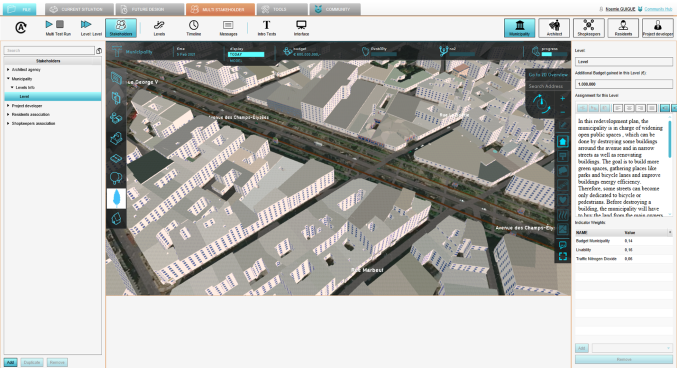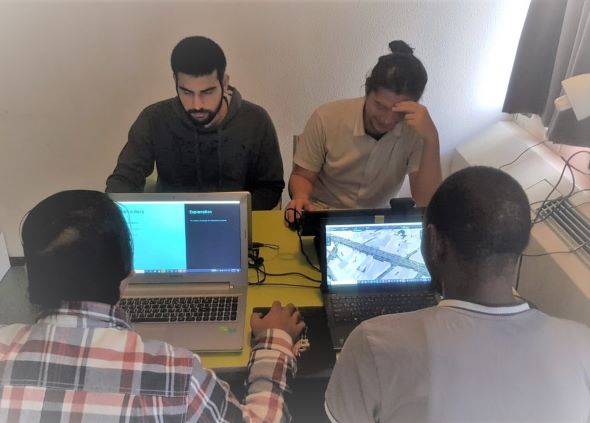Tygron EDU Manual: Difference between revisions
| Line 102: | Line 102: | ||
====Syllabus and logistics==== | ====Syllabus and logistics==== | ||
[[File:ParisGameSchedule. | [[File:ParisGameSchedule.png|thumb|250px|right]Schedule of the course as designed by IHS] | ||
[[File:GroupworkingIHS.jpg|350px|frame|center|IHS students working on their group assignment from home.]] | [[File:GroupworkingIHS.jpg|350px|frame|center|IHS students working on their group assignment from home.]] | ||
Revision as of 13:42, 24 February 2021
Introducing the EDU Manual
In the past years, many educational institutes have managed to integrate the Tygron Geodesign Platform in their curriculum. They did that by delivering different courses to students from various backgrounds. The implementation of these courses resulted in varying levels of outcomes; some were more successful than others.
In some cases, lecturers ran into problems with their courses. Most of the time the problems were technical or logistical. For instance, the outcome of a course was compromised because the course-assignment has not been properly set up, or because students ran into hardware problems.
During last year’s Tygron EDU Event (2020), participants expressed their desire for an educational manual. The main goal of this manual is to provide educational institutes with successful use-cases, of different learning objectives, in order to help them implement the use of the Tygron Platform in effectively in their curricula.
This manual is a practical manual designed to help the lecturers get a grip of what is needed to set up a successful course that could be delivered repetitively for multiple years.
By using this manual, you will be able to:
- Learn how other institutes have been using Tygron in their educational curricula;
- Understand the content and the design of the courses, including time-distribution, target students, logistics, challenges, outcome and assessment, and other important details;
- Take into consideration others’ recommendations and feedback based on their experience.
This manual is composed of:
- Existing courses and use-cases of Tygron, with 5 different learning objective
- The outcome of each use-case presented in the form of reports, pictures, and videos
- PowerPoint presentations with the most relevant functions for each learning objectives
Overview of the Learning Objectives and Use-Cases
Tygron has been used for courses related to different objectives such as:
- Urban Analysis
- Geographic Information System (GIS)
- Spatial Planning
- Scientific Research
- Decision-Making
For each of the mentioned learning objectives, we have selected one successful use-case of Tygron. Below are the use-cases for each learning objective:
1. Tygron for Urban Analysis: “Urban Water Course”
A 9-week course delivered by Van Hall Larenstein to water management students at the HBO level. During this course, the students were divided into groups, and each group was assigned a different neighborhood within the Lelystad region. Students had to use Tygron to develop a sustainability plan for their chosen areas while focusing on flooding, heat and livability.
2. Tygron with GIS data: “Planting Trees to Reduce Heat Stress”
This use-case describes how a student of “International Land and Water Management” at Wageningnen University used Tygron platform in his 4-week GIS course to prepare for his Bachelor research. Contrary to his course-mates who used other software, the student had chosen Tygron to explore the most effective way of planting trees to reduce heat stress in Rivierenwijk in Utrecht.
3. Tygron for Spatial Planning: “Proposals for a Greener Hoefkade”
In this use-case, a group of students of very different backgrounds used Tygron to develop an eco-consultancy plan for the municipality of the Hague, as an assignment for an area study course within their Sustainable Development interdisciplinary minor at the University of Leiden. In 4 weeks only, the team learned Tygron and created a complete plan for a greener Hoefkade neighborhood.
4. Tygron for Research: “the Virtual River Game”
A PhD candidate at the university of twente was assigned to create a serious game that would facilitate stakeholder engagement in river management as part of the RiverCare research program. Five years later, the result was the virtual river game, a unique board-game that is digitally connected to the Tygron platform. By manipulating the pieces on the board, stakeholders can immediately see the calculations and graphs on the Tygron screen.
5. Tygron for Decision-making: “Scenario Building”
IHS developed a Scenario Building course for its Master students of the “Urban Environment Sustainability and Climate Change” specialization. In less than 5 days, and with no prior experience in Tygron, each group of students constructed their own development story by defining potential stakeholders and targets, then played a simulation game that would resemble stakeholder interaction in real life.
It is important to note that each use-case is different, and that lecturers are constantly fine-tuning their courses. That is why, the manual is designed to highlight the practical issues of the courses, and not only their content. This manual will be constantly updated and we will be adding more use-cases with time.
1. Tygron for Urban Analysis: “Urban Water Course”
Background Information / comparison with last year
Content of the course
General information
Target students
Objectives and desired outcome
Design of the Course
Syllabus and time distribution
Guidance and Resources
Outcome and Assessment
Feedback and recommendations
5. Tygron for Decision-making: “Scenario Building”
FFor a few years now, IHS has been using Tygron as a scenario building tool within its s"Urban Management Tools for Climate Change" short courses. During this course, tthe Tygron support team would join the students for half a day to help them play the Climate Game. Last year (2019-2020), IHS decided to experiment with implementing Tygron for one of its Masters specializations. The course was given as an elective for 15 students, and the implementation was completely successful. This success has pushed IHS team to design and implement a mandatory course using Tygron as part of the new curriculum. Contrary to last year, due to the COVID-19 restrictions, the course was completely done online this year.
Content of the course
General information
- Name of the course: "Scenario Building for Sustainable Cities"
- Study-block: "Applications of ICT for Smart and Sustainable Cities"
- Study Programme: Masters in Urban Environment Sustainability and Climate Change.
- Educational Institute: Institute for Housing and Urban Development Studies (IHS) of the Erasmus University Rotterdam.
Target students
The course is designed for 30 students coming from different backgrounds, without any prior knowledge of Tygron or other geodesign software. The students are expected to have some knowledge in decision-making, but no specific skill sets or tools are required upon entering this course.
Objectives and desired outcome
The students are expected to learn planning and decision making for sustainable cities in a multi-stakeholder environment.
To do that, the lecturer and the teaching assistant have created a model case study based on the Champs-Elysées area in Paris using Tygron. They called the model the "Paris Game". It is inspired from an existing redevelopment plan of the Paris municipality, with modified objectives.

The students are expected to form teams of 4-5, and design scenarios for improving sustainability of a chosen or given area, while creating a multi-stakeholder decision making environment.
More-specifically, each team is expected to develop its own scenario for this area by:
- Creating a story; defining the potential involved stakeholders, their indicators, their goals, their budget, etc.
- Simulate the interaction between stakeholders by playing the "game' as if in real life.
Design of the Course
Syllabus and logistics
[[File:ParisGameSchedule.png|thumb|250px|right]Schedule of the course as designed by IHS]
